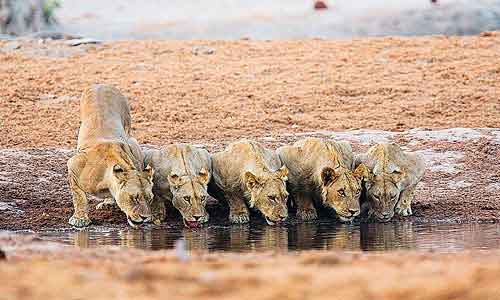Planet Earth

LET ME TELL YOU about patience and perseverance in the pursuit of great television.
The camera crews of The Discovery Channel's "Planet Earth" waited 45 days in the New Guinea forests for the opportunity to film the bizarre mating dance of the Blue Bird of Paradise.
That's awesome dedication.
Here is an even better example: Cinematographer Doug Allan spent three years trudging up and down the Himalayas in the hope of photographing the rarely seen snow leopard.
In the first episode of the 11-part "Planet Earth" series premiering at 8 p.m., Sunday you'll hear Allan say, as he waits all bundled up against the cold, "Of course this is boring. Boring as hell."
But the boredom dissolves into excitement when there at last, within camera range, is the magnificent ghost cat with fur that's a blend of white and gray.
The picture of the snow leopard alone is worth what you paid for cable this month.
"Planet Earth" is one stunning series of high-definition images after another, including pictures of a cat they call the rarest on Earth - the amur leopard of far east Russia. Experts who study the big cats say the population of the amur leopard has dwindled to fewer than 40.
David Attenborough, who was the series narrator when it premiered on the BBC in 2006, told an online source, "The series is a celebration of our planet, not a lament about the state of it. In some areas there is no doubt that we are doing damage to our world, but at the same time we should be aware of a vast amount of uncharted and untouched wilderness."
ON TV
"Planet Earth" premieres Sunday at 8 p.m. on
The Discovery Channel.
Television as far back as the early 1960s discovered that critters doing what comes naturally captivate viewers. "Mutual of Omaha's Wild Kingdom" with Marlin Perkins and Jim Fowler debuted on NBC in 1963. It continued on the network and later in syndication until the late 1980s.
"Nature" on PBS has had a marvelous 25-year run. The Learning Channel and The Discovery Channel on cable provide platforms for animal exploration seen by millions. The Animal Channel premiered 11 years ago, but until "Planet Earth" came along, television's coverage of animals in motion rarely reached the level of art.
"You're in for a treat," said Sigourney Weaver when "Planet Earth" was introduced to the press in Silver Spring, Md. "The camera work is so extraordinary."
She replaces Attenborough as the narrator for the U.S. run of "Planet Earth," in which the viewer enters the world of the beast in more than 200 locations with 70 camera crews to record this and much more: the mass migration of a million caribou in the Arctic... mere mortals challenging nature on some of the tallest mountains on the planet... the spectacular sandstorms of the Sahara... predators such as wolves, lions and even eagles preying on the wildebeest of east Africa... a pride of African lions hunting elephants at night.
Run out right now and buy a high-def TV to watch this series.
Of focusing on brutality in the bush, Executive Producer Alastair Fothergill said, "We had to tread a fine line between showing nature as it really is while not offending the sensibilities of the viewers. I think it's an enormous mistake to try and sanitize nature."
It's high drama when Fothergill's camera crews in a helicopter equipped with a 360-degree lens track wild dogs running like the wind to bring down impala in Botswana.
If that's too intense for you, revel in previously unseen footage of grizzly bear cubs in the Rockies leaving their den for the first time. You'll love it.
# Reach Larry Bonko at (757) 446-2486 or larry.bonko@pilotonline.com.
Libellés : film

0 commentaires:
Enregistrer un commentaire
Abonnement Publier les commentaires [Atom]
<< Accueil